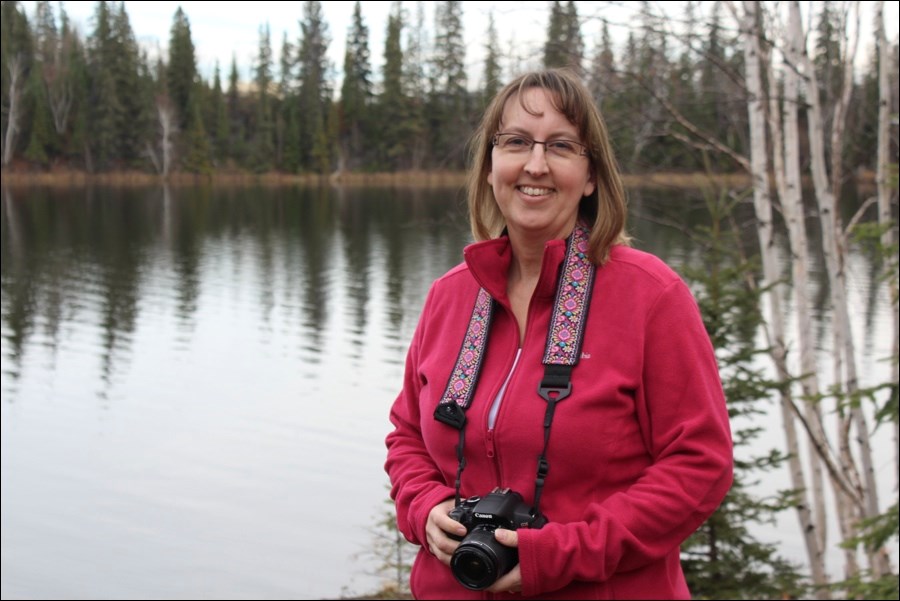The night has fallen over Schist Lake and the Northern Lights are dancing. A photographer carefully sets up her tripod.
After she has constructed her shot, the shutter on Kathy Schwartz’s camera closes quickly, making a mechanical ‘squeak’ noise.
Silence. Then, 15 seconds later, a click. The photo is complete.
Schwartz, a small-business owner and quiltmaker, has been pursuing her hobby of photography since her teenage years.
“I think I bought my first camera when I was 16,” she said. “I carried it with me everywhere.”
She can’t pinpoint the exact moment that led her to become a shutterbug, but can easily recall why she has stayed with the hobby.
“I think I just always enjoyed being behind the camera,” said Schwartz, at her home on Schist Lake. “I didn’t like having my picture taken, I always was the one with my group of friends growing up taking the picture. I don’t remember taking a picture and going, ‘Oh my god, that’s life-changing.’ It was quite a gradual progression.”
After some time spent away from the camera, Schwartz moved to Flin Flon with her husband Tim, now a geologist with Hudbay. Indirectly, it was her husband who led her back towards taking photos.
“I got a little interested in my husband’s DSLR camera,” she said. “I started borrowing it and after a while, I was using it all the time. He finally said, ‘Okay, I’m getting you one for Christmas!’ It was about four years ago, and I haven’t looked back.”
In those four years, Schwartz has garnered attention online for her photos, usually of wildlife, nature and the night sky, including that occasional visitor on cold Flin Flon nights, the Northern Lights.
“I’ve become quite obsessed with them,” said Schwartz. “I have an app on my phone that I check every night to see if they’ll be out. I’m disappointed if they’re brilliant and it’s cloudy. We missed quite a few opportunities this month.”
For Schwartz, the formula for a good photo of the Northern Lights is simple: a long exposure – about 10 to 15 seconds – along with a low ISO.
Having the right equipment is vital: Schwartz suggests not using filters, having a sturdy tripod and, most importantly, a remote shutter release to cut out any accidental camera shake.
“That bumped up the game considerably,” she said. “What I was doing before was putting it on a two-second delay, so I was hoping I wouldn’t get that, but I think I still was.”
Aside from equipment suggestions, Schwartz’ biggest tip for budding shooters is not to wait for the shot to come to you – go to where the shot will be.
“You have to drive outside of town. You have to make the effort,” she said. “I remember reading an article saying, ‘Don’t be the lazy photographer.’ You’ve got to go search it out. If you want that picture, you have to go get it.”
Schwartz travelled to Churchill this summer to take photos, ending the trip with shots of beluga whale pods, snow owls and even a family of polar bears on the shore of Hudson Bay.
“That was quite an experience,” she said. “You can tell a story with pictures, the whole experience and the memories associated with that. Taking pictures of the bears, I wasn’t just focused on the bear. It was the outcropping in the background, all the flora and fauna in bloom, the shoreline, it was all important to me.”
Schwartz hopes to take her camera gear on the road and travel further to take photos in the future, including to Australia. In the meantime, she is also focusing on growing her quilting business, a company that her photography sideline has helped promote.
Since she began posting her photos on her business’ web pages, Schwartz has received quilt-work from around the globe.
“With exposure through my blog, I’ve got quilters from around the world sending me their quilts – Germany, South Africa, Peru,” she said. “That’s been amazing. It keeps me very busy.”




